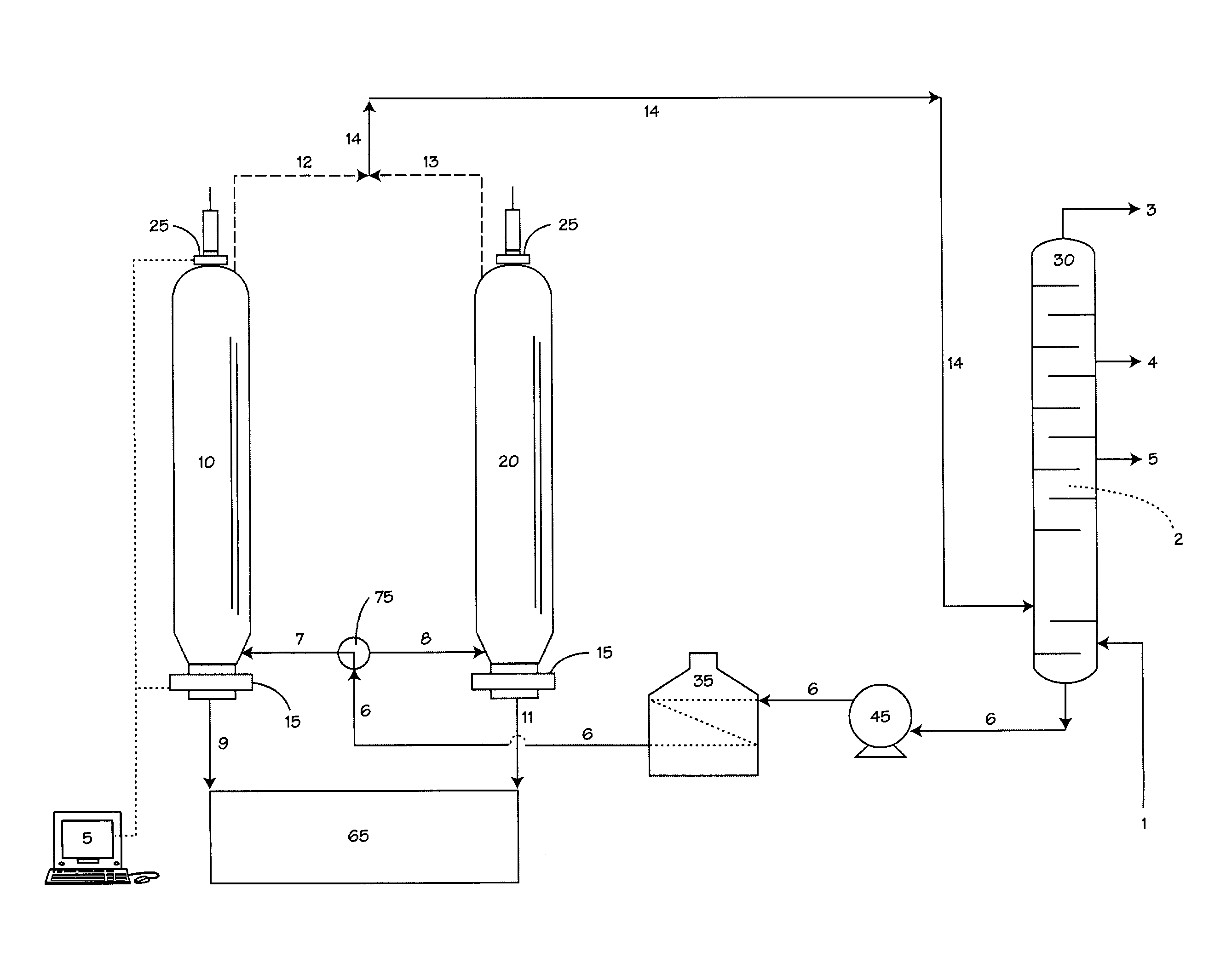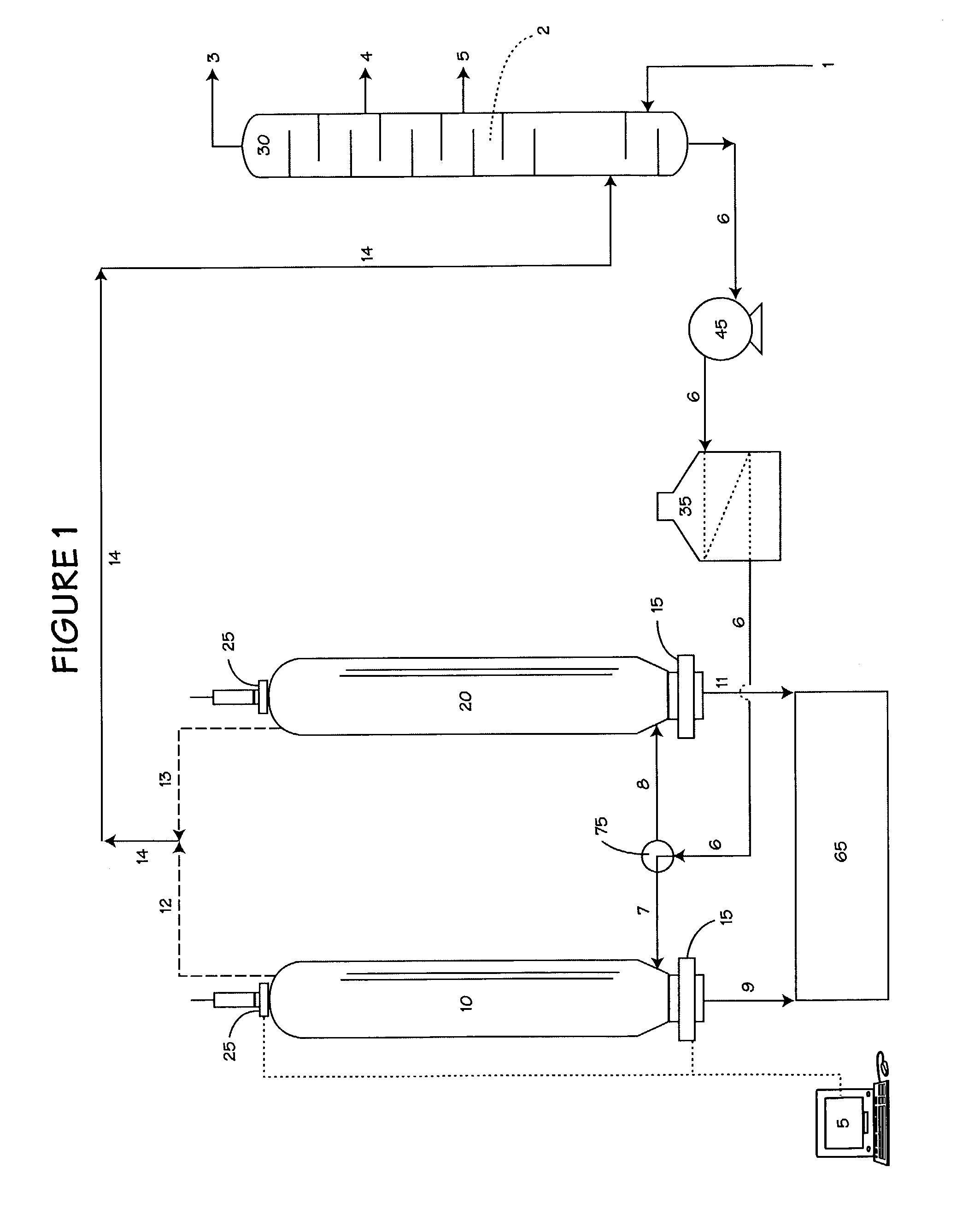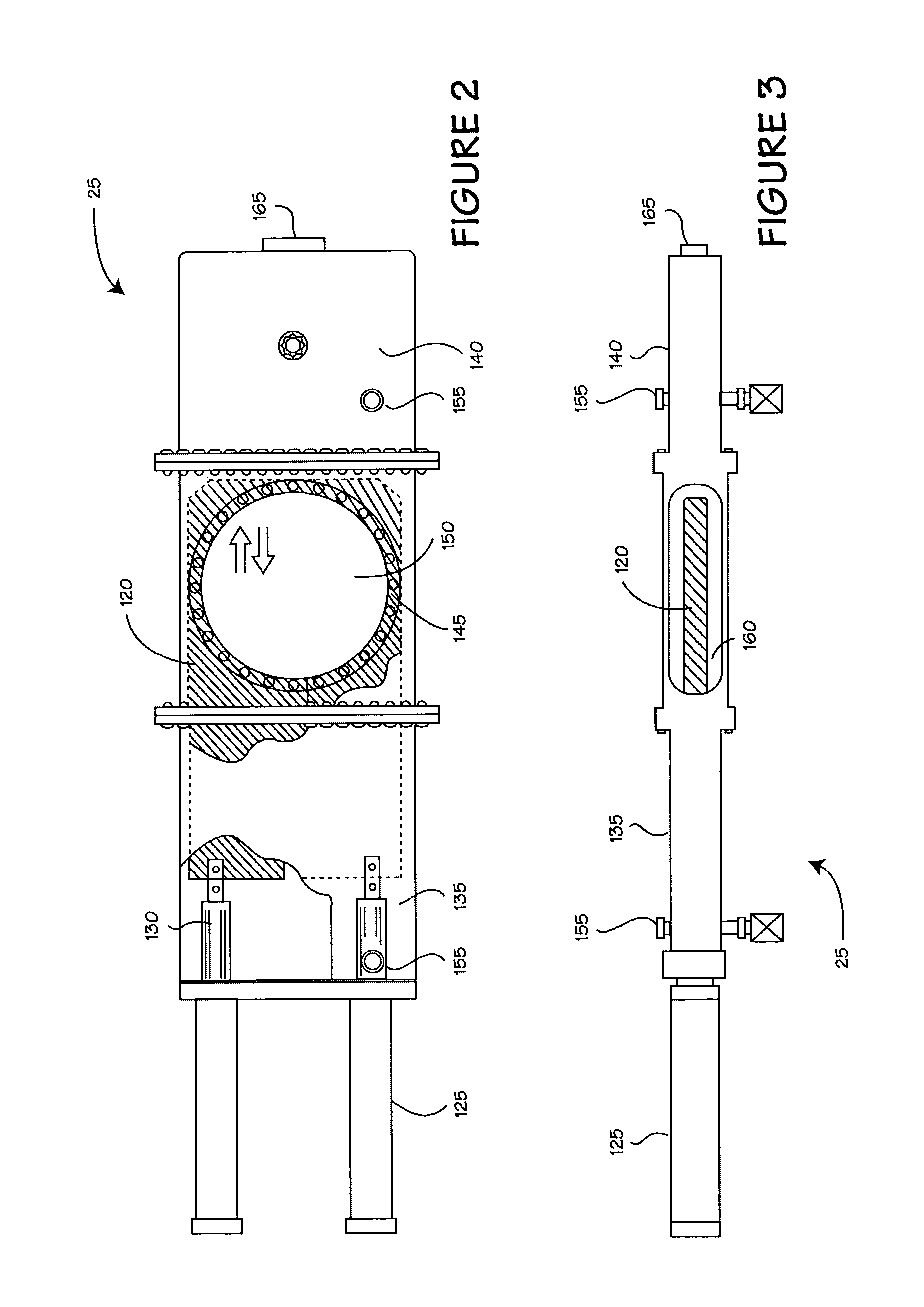[0011]According to the present invention, a process and apparatus are provided for repetitively producing and removing coke from a
delayed coker vessel without unheading the vessel top, wherein the coker vessel has a top portion having an aperture through which coke is prepared for removal, comprising: (a) sealing an aperture closure housing to the top portion of the coker vessel; (b) sealing a
cutting head
enclosure to the aperture closure housing; (c) inserting a cutting head into said
enclosure wherein said cutting head is attached to the distal end of a vertically rotatable shaft; (d) moving a horizontal closure member within the closure housing to open the aperture of the coker vessel top; (e) rotatably lowering the cutting head by means of the shaft through the vessel aperture into and through coke contained in the vessel; (f) injecting a fluid through a plurality of nozzles attached to the cutting head at a pressure sufficient to
cut and dislodge coke from the vessel; (g) raising the cutting head to the position of step (c); (h) moving the horizontal closure member within the closure housing to close the aperture to the coker drum; and (i) repeating steps (c) through (h) through successive coking / decoking cycles. In a preferred embodiment of the invention the closure member is power actuated, such as hydraulically, by remote means, thus obviating any need for personnel to be physically present in the vessel top area during decoking operations.
[0012]The
delayed coker vessel of the present invention comprises a vessel having a top aperture; a top aperture closure housing sealed to the top aperture; a horizontal closure member moveable within said closure housing; a cutting enclosure sealed to the top portion of the closure housing including a blowback / guide ring
assembly (referred to as a blowback /
cutting guide) attached to the upper portion of the cutting enclosure; and a coke cutting apparatus seated within the cutting enclosure centrally above the top aperture. The combination of the closure housing and moveable horizontal closure member therein is herein termed a closure unit or valve. In one embodiment of the invention the top portion of the coker vessel is designed and fabricated to be directly sealed to the closure unit, whereas in another embodiment, particularly useful for
retrofitting existing coker vessels, an upper transition piece herein termed a spool, is interposed between the vessel top and the closure unit and pressure-tightly sealed to both. In either of these two embodiments, a preferred feature is that the closure housing is pressure-tightly sealed to either (a) the coker vessel or (b) the spool piece. Preferably the pressure-tight seals will withstand pressures within the range of about 100 psi to 200 psi, preferably within the range of about 125 psi to about 175 psi and most preferably between about 130 psi to about 160 psi. In addition to the pressure-tight seals mentioned above, there is a pressure-tight seal between the said horizontal closure member and the valve body seat. The valve body is steam pressured to insure positive isolation from the
atmosphere during the coking / decoking cycles. The valve body seat design and steam purge prevent leakage of the coker vessel contents during operation thereof at temperature ranges between about 800° F. and 950° F. and the aforementioned pressure ranges.
[0013]The present invention substantially reduces or eliminates the dangerous and
time consuming procedure of heading and unheading
delayed coker vessels, thus rendering the decoking procedure
safer for personnel to perform by insulating them from
exposure to
high pressure water jets, hot coke,
high pressure steam,
scalding water, mobile
heavy equipment and other extreme hazards. Among other factors, the present invention is based on our conception and finding that coke is safely and efficiently removed from a delayed coker vessel by the
closed system process described herein, sometimes visualized by us as a “closed-
pipe” system, which includes a pressure-tight seal between a closure housing and the coker vessel top aperture similar to the bottom aperture and valve system described in U.S.
patent application Ser. No. 10 / 043527. The vessel top aperture, which opens and closes, preferably includes automatic and
remote operation of a closure unit, such as a valve, located at the top of the coker vessel rather than unbolting and removing or swinging away a “plate blind” or “head” as in the prior art. One aspect of enabling the process of the present invention is having a single mechanical “head” system that serves multiple functions such as opening and closing the coker drum, and facilitating penetration of the drilling mechanism into the coker drum without removal of the mechanical head. In prior art, the manual and
semi automatic modes of heading and deheading the top of coker drums requires two mechanical heads, one for closing the coker drum to maintain positive
process isolation, and one for guiding of the
drill assembly into the coker drum.
[0014]One preferred embodiment of the present invention is based on our finding that coke removal is efficiently and safely carried out using a permanently attached cutting head enclosure which is pressure-tightly sealed to the top of the closure housing. The cutting head enclosure, which preferably remains attached without removal throughout repetitive coking / decoking cycles, facilitates safe and efficient operation of the coke drilling mechanism by providing a sealed enclosure and maintaining alignment of the mechanism directly above the coker valve aperture and during the coke drilling process. This feature significantly enhances worker protection and safety by isolating the hydraulic cutting head from workers and reducing the time to remove coke from the coker drum by having the coke cutting apparatus in position and ready to start the decoking process, as soon as the coker aperture is opened. Other unique features include a cutting head maintenance access door to enable easy service and maintenance of the coke cutting head apparatus, and a
safety shield or blowback prevention device to contain the high pressure cutting water, the
hot liquids, coke particulants, steam, and hydrocarbon emissions during the cutting and dislodging of the coke from the coker drum.
[0015]Another preferred embodiment of the invention is a method and apparatus for automatically opening and closing a vessel top aperture by means of a closure unit or valve, in lieu of the removable or partially removable head devices described in the prior art, and without the associated safety and efficiency drawbacks discussed above. In a preferred embodiment, which takes the place of the prior art removable closure flanges, spool pieces bolted to a stationary vessel flanges, hinged flanges, carts, carriages and the like, powered devices, which may be controlled automatically, move a closure member within a closure housing between open and closed positions. These powered devices may comprise any powered actuators, including motors, solenoids, or the like, but preferably comprise linear actuators such as hydraulic or pneumatic cylinders with reciprocating
piston rods. Such actuators may be mounted on the vessel closure housing or other stationary location to reversibly and repetitively move the closure member from an open to closed position. Preferably the method of the invention does not typically require direct human intervention in proximity to the vessel top to actuate the powered devices, which is preferably accomplished by remote
instrumentation means such as an electronic
relay system or computer controlled system. The entire process is, thus, done safely and without significant or dangerous physical effort.
[0016]Although secondary to the significant safety improvements, the present invention also substantially shortens the time required to complete decoking, without compromise in
human safety or effort. The invention also renders the addition of this new closure device onto the hundreds of existing coker vessels to a relatively simple, quick, and inexpensive procedure, as compared to the difficult, expensive, and
time consuming requirement of the existing methods and devices of the prior art described above.
 Login to View More
Login to View More 


